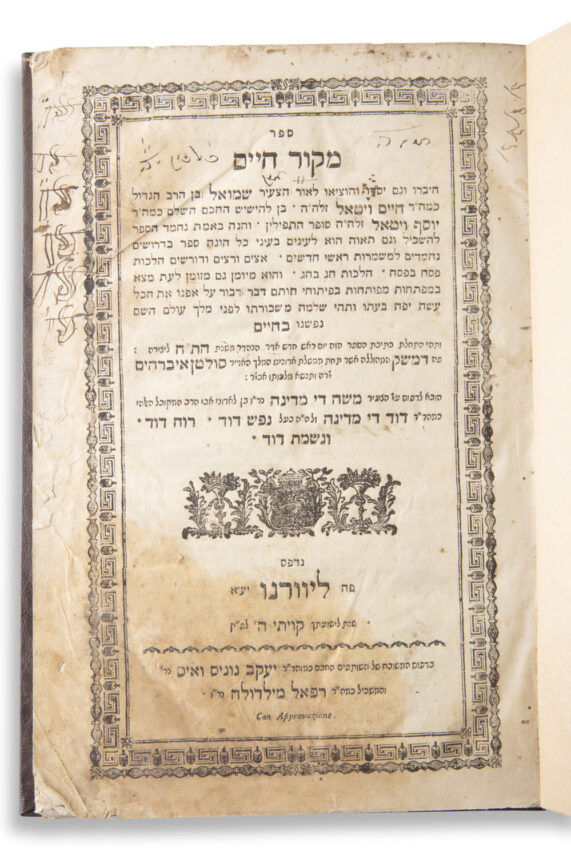Russians, Jews and literature scholars get excited about jubilee years, and for those who fit any of these categories, 2009 is a big year. One hundred and fifty years ago this month, a writer who would immortalize the Russian Jew in literature, Solomon Rabinovich (1859-1916) — better known by his literary persona, Sholem Aleichem — was born in the town of Pereyaslav, near Kyiv. This spring also marks the 200th birthday of Nikolai Gogol (1809-1852), who was born about 100 miles to the east of Kyiv, in the town of Sorochintsy. Gogol, too, helped to immortalize the Russian Jew in literature, but in a more problematic way: the Jews who crop up around the margins of his stories, most of them crafty market vendors, money-lenders and tavern keepers, are anti-Semitic stereotypes, an unsettling detail in the work of one of the greatest comic writers of modern literature.
Literary history rarely moves in a straight line. Gogol and Sholem Aleichem may have written in different languages and represented different cultures, but their lives, remembered together, offer a vivid picture of the interplay of Russian and Jewish cultural history, and their stories, read side by side, appear as if in conversation. Both writers were obsessed with the dangers of commerce and capital, a theme that renders them all the more current in 2009. Both hail from what is now Ukraine, and each came to be viewed as a literary ambassador from an ethnic group within Russian culture. Gogol knew Russian and Ukrainian, attended a Russian school, moved to Petersburg to become a writer and spent years traveling in Western Europe. Sholem Aleichem attended both a Jewish cheder and a Russian secondary school, a marker of assimilation in a Jewish family. He began writing in Russian and Hebrew, but found success in Yiddish. Like Gogol’s tales of Ukraine, which sounded quaint to the Russian elite, Sholem Aleichem exported tales of the Jewish Pale of Settlement to cosmopolitan readers via publications in Warsaw and Petersburg, and visits to the United States.
Best known in the United States for his Tevye character, who became a symbol of the Jewish departure from Eastern Europe thanks to the Broadway musical “Fiddler on the Roof,” Sholem Aleichem was canonized in the Soviet Union as the representative Yiddish writer, and an abridged six-volume Soviet edition of his works, in Russian translation, was as expected a collection in any Soviet Jewish household (and in many non-Jewish households) as the collected works of Lenin or Tolstoy.
Gogol, now best known for his later works, like “Dead Souls,” “The Overcoat” and “The Inspector General,” first became famous for his tales of provincial Ukraine, which he peopled with an amalgam of Ukrainians, Russians, Jews, Poles and Gypsies. In his first successful story, “The Sorochintsy Fair” (1830), we marvel at how “a gypsy and peasant smacked hands then squealed from pain; how a drunken Jew slapped a woman on the backside; how vendors who had been arguing hurled profanities … and crayfish; how a Russian stroked his goatish beard with one hand, while with his other … “ In this story, a Jew buys and sells a demon’s coat, infecting an entire fair with evil. Gogol’s Jewish characters increase the sensation of a tale told from the margins of the Czarist Empire and often provide a moral lesson about overzealous trade.
Jewish stock characters later appear in Gogol’s epic novel, “Taras Bulba” (1835 and 1842), based loosely on Bohdan Chmielnicki’s Cossack uprising against Polish Magnates in 1648, an event in which thousands of Jews were killed. “‘Hang all the Jews!’ rang out from the crowd, ‘don’t let their Jewesses sew skirts out of our priests’ garments!’” In this story, a Jew, Yankel, escapes a pogrom in his shtetl but eagerly betrays his community by offering products and services to the Cossack warriors for the right price. “Taras saw that his protégé Yankel had already managed to erect a stall with an awning for himself and was selling flints, handfuls of gunpowder in paper cones, and other military items — even bread rolls and dumplings.”
Little surprise, given the stereotypes sprinkled throughout his work, that Gogol has been dismissed by Jewish readers, from the Russian historian Dubnow to the Soviet critic Mashinsky, as one of Russia’s many literary anti-Semites. But Sholem Aleichem chose to model much of his writing, and even his appearance, on Gogol. Ruth Wisse, in “The Modern Jewish Canon” (University of Chicago Press, 2003), has called Sholem Aleichem “the Jewish Gogol.” David Roskies, in “A Bridge of Longing: The Lost Art of Yiddish Storytelling” (Harvard University Press, 1995), reminds us, “Rabinovich kept a box marked ‘Gogol’ on his desk for work in progress, often quoted Gogol in private correspondence, and even wore his hair as Gogol did.” Had the two writers, with their dandyish bobs and whiskers, lived at the same time, they might have been mistaken for one another.
What Sholem Aleichem was borrowing from Gogol was a rural East European landscape that may have been dangerous, but could unite readers through the power of collective memory. He also learned from Gogol to soften this danger through laughter, and he often rewrites Gogol’s Jewish characters, correcting anti-Semitic stereotypes and narrating history from a Jewish perspective. Gogol’s heavily caricatured Jew tends to profit against all odds at Ukrainians’ expense, but Sholem Aleichem’s characters (like the author, who lost his inheritance in the Kiev Stock Exchange in 1890) are usually failures at trade, and their living conditions are squalid.
Sholem Aleichem devotes numerous stories and two full volumes to “Kasrilevka,” a fictional shtetl based, in part, on his childhood village, Voronka. The first, “Old-New Kasrilevka,” is a parodic Baedeker: “They turn out ‘A Guide to Moscow,’ ‘A Guide to Berlin,’ ‘A Guide to Paris,’ so why shouldn’t we have ‘A Guide to Kasrilevka?’ The guidebook includes seven sections, decreasing in appeal: “Transportation,” “Hotels,” “Restaurants,” “Liquor,” “Theater,” “Fires,” and “Bandits.” Eastern Europe was increasingly threatening to Jews, and Sholem Aleichem subtly expresses this by depicting the most despicable elements of the shtetl. Sholem Aleichem’s popular Menachem-Mendl stories (written between 1896-1913) find the title character traveling the world inventing get-rich-quick schemes. His adventures begin when he is given, in place of a promised dowry, a small sum of cash, two promissory notes and an illegitimate “draft” on bad credit (to be redeemed in Odessa). Menachem-Mendl’s wife, Sheyne-Sheyndl, remains at home in Kasrilevka, alternately scolding her husband for his bad investments and sending him money when his ventures fail. Gogolian characters occasionally appear in her shtetl. In one letter, she writes that a government inspector has arrived in town to ascertain what has become of certain sums of money meant for charity, an echo of Gogol’s “Inspector General,” whose anticipated arrival shakes a town to its core, unearthing the illegitimate finances of its provincial elite.
Sholem Aleichem’s 1900 “The Haunted Tailor” begins with a mock-biblical description of a community’s poverty:
And it came to pass that Tsippa-Beyla-Rayza was returning one summer day with her basket from the market, she threw down her bundle of garlic with a little parsley and potatoes that she had bought, and cried angrily, “This can all go to hell! Enough of thinking up what to cook for dinner. You have to have the head of a prime minister! Dumplings with beans and again dumplings with beans. May God not punish me for these words! But even Nekhame-Bruchkhe, who is destitute, miserable, a charity case, she has a goat!
For all their apparent misery, Sholem Aleichem’s hapless characters inspire the Yiddish reader to imagine a world that is not limited to the confines of the shtetl. This incitement to imagination looks something like the conversation, in Sholem Aleichem’s 1902 story set in Kasrilevka, “Seventy-Five Thousand,” between Yankev-Yosl and his wife, Ziporah, when the former has (erroneously) decided he has won a jackpot of 75,000 rubles:
“How much have we won?” she says, gazing right into my eyes, as if saying: “Aha! You’re lying, but you’re not gonna get away with it!”
“Gimme a for instance — how much do you figure we’ve won?”
“I have no idea,” she says. “Maybe a few hundred rubles?”
“Why not,” I say, “a few thousand rubles?”
“What do you mean by a few thousand?” she says. “Five? Six? Maybe as much as seven?”
“You can’t,” I say, “imagine more?”
(Translation by J. Neugroschel in “No Star Too Beautiful: A Treasury of Jewish Stories,” W. W. Norton & Company, 2004).
Sholem Aleichem wants his readers to imagine more, even if the ticket to get there proves to be one number off. His fiction, borrowed in part from Jewish literary sources and in part from Russian writers like Gogol, was, in its own way, revolutionary.
On May 15, 1916, when Sholem Aleichem was buried in the Mount Neboh Cemetery in Cypress Hills, Queens, his headstone was inscribed with his original epitaph, which ends with the following lines:
“And just as the public was
Laughing, chortling, and making merry
He suffered — this only God knows —
In secret, so that no one should see.
(Un davke demolt ven der oylem hot
gelakht, geklatsht, un fleg zikh freyen,
hot er gekrenkt — dos veys nor got —
besod, az keyner zol nit zeyen.)
The epitaph echoes Gogol’s famous “laughter through tears” passage from “Dead Souls,” which Sholem Aleichem used to keep, in a Yiddish translation, on his desk:
And for a long time still I am destined by a wondrous power to walk hand in hand with my strange heroes, to view the whole of hugely rushing life, to view it through laughter visible to the world and tears invisible and unknown to it! (translation by Pevear and Volokhonsky, Everyman’s Library, 2004).
As a writer, Gogol struggled with his simultaneous terror of a changing world and desire to entertain his readers through comedy. According to Isaiah Berlin (1909-1997: what did I tell you about 2009?), Gogol’s world vision was as single-minded as Tolstoy’s was. Sholem Aleichem was not nearly so single-minded. Rather than worrying about the dangers of foreign influence on the Russian Empire, he worried about the dangers in Russia for Jews, its perennial foreigners. But he did share Gogol’s struggle between tradition and creativity. The fine line separating Yiddish literature as a means of inciting social change, and social change as a force destroying Yiddish, gave Sholem Aleichem the fear of loss that he would take with him, quite literally, to the grave.
Sholem Aleichem enclosed his epitaph in his Last Will and Testament, written a few months before his death. In the first of 10 points outlined in his will, the Yiddish writer specified that:
Wherever I die, I wish to be buried not among aristocrats, big shots, or wealthy people, but precisely among ordinary folk, workers, the real Jewish people, so that the gravestone which will be placed on my grave will beautify the simple graves around me, and the simple graves will beautify my grave, just as the simple, honest folk during my life beautified their folk-writer. (Translation by Zuckerman and Herbst in “Three Great Classic Writers of Modern Jewish Literature, V. II,” Joseph Simon Pangloss Press, 1994.)
With this final wish, Sholem Aleichem promises to remain near those readers whose spirit he sought to evoke through the shtetls of his fiction, and, of course, in a more subtle way, he also remains with the memory of Nikolai Gogol.
Amelia Glaser is assistant professor of Russian and comparative literature at UC San Diego. She is currently completing a book about rural commerce in Russian, Ukrainian and Yiddish literature. She also translates poetry and prose from Russian and Yiddish; her translations include an anthology of Yiddish poetry, “Proletpen: America’s Rebel Yiddish Poets” (U. Wisconsin Press, 2005).

































 More news and opinions than at a Shabbat dinner, right in your inbox.
More news and opinions than at a Shabbat dinner, right in your inbox.